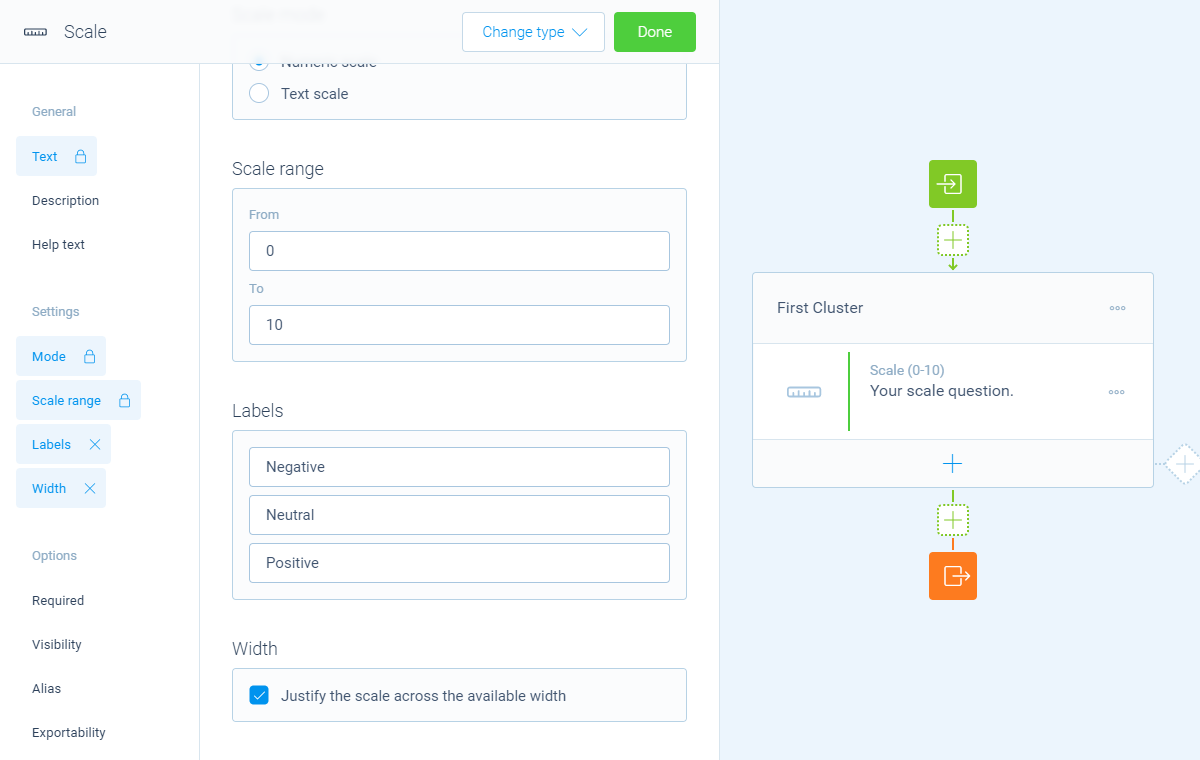How to use the scale block
Learn everything you need to know to use the scale block in your forms.
When to use
Use the scale block to let your respondents select an opinion on the scale you provide them, for example for a Net Promoter Score (NPS) on the scale from 0 to 10. But you can also use texts scales instead of numeric scales.

How to use
Add a new block to your form and then select the question type Scale. You can now customize this block to your needs with the following features:
General
- Text
Use theTextfeature for the name/title of this block. - Description
Enable theDescriptionfeature to add a description to this block. - Help text
Enable theHelp textfeature to add a help text to this block.
Settings
- Mode
TheModefeature is always activated. You can select if your scale is aNumeric scale(for example from 0 to 10) or aText scale(for example from bad to good). Depending on this setting, one of the following features gets activated:- If you selected a numeric scale, you can determine the
Scale range. You can even use negative scales over here. - If you selected a text scale, you can compose the list of choices you want to show. You can add choices one by one, or import a list of choices from a text file at once.
- If you selected a numeric scale, you can determine the
- Labels
Enable theLabelsfeature to add labels that are shown on the left, center and/or right of the scale. - Width
Enable theWidthfeature to determine if the width of the scale should be fixed or the scale can grow with the size of the screen of the respondent. - Score
You can attach scores to the choices to perform instant calculations. Enable theScorefeature to enter the desired score values. This feature is only available if your scale mode is set to text scale.

Options
- Required
By default this block is not required to fill out by your respondents. Enable theRequiredfeature to make this block required to fill out. - Visibility
By default this block is visible in your form. Enable theVisibilityfeature to hide it for your respondents. - Score
You can attach scores to the choices to perform instant calculations. Enable theScorefeature to enter the desired score values. This feature is only available if your scale mode is set to text scale. - Alias
By default the name/title of this block will be used in your dataset. Enable theAliasfeature to use a different name in your dataset. - Exportability
By default the collected data of this block will be stored to the dataset of each result. Enable theExportabilityfeature to take control over the storage. You can then include/exclude the data from your dataset. Please note that if you exclude data from the dataset you can never see and/or use the given answers from your respondents to this block, because the data is simply not stored at all.
Choices (text scale)
If your scale mode is set to text scale, you can open each scale option to get to the settings of that single option. Over there you can use these features:
- Name
Use theNamefeature for the name/title of this choice. - Identifier
By default the name of each choice will be used in your dataset. Enable theIdentifierfeature to use a different name in your dataset. - Score
Enable theScorefeature to enter the desired score value for that choice.
Logic (numeric scales)
Logic is important to make your forms smart and conversational. The scale block with a numeric scale can work with the following branch conditions to help you with that:
Block conditions
- Match the scale value selected.
Evaluate conditions
- Value is equal to
your filter; - Value is not equal to
your filter; - Value is lower than
your filter; - Value is higher than
your filter; - Value is between
your filters; - Value is not between
your filters; - Value is empty;
- Value is not empty.
Filters
When we mention your filter(s) above, there are some different filters that you can use to make the right comparison:
- Number - Compare with a fixed number that you enter;
- Value - Compare with another block value entered in the form by a respondent (more info).
Logic (text scales)
The scale block with a text scale can work with the following branch conditions to help you with that:
Block conditions
- Match one of the options;
- Unanswered.
Evaluate conditions
- Value matches
your filter; - Value does not match
your filter; - Value contains
your filter; - Value does not contain
your filter; - Value starts with
your filter; - Value ends with
your filter; - Value is empty;
- Value is not empty.
Score conditions
- Score is equal to
your filter; - Score is not equal to
your filter; - Score is lower than
your filter; - Score is higher than
your filter; - Score is between
your filters; - Score is not between
your filters; - Score is calculated;
- Score is not calculated.
Filters
When we mention your filter above, there are some different filters that you can use to make the right comparison:
- Text - Compare with a fixed text that you enter;
- Value - Compare with another block value entered in the form by a respondent (more info).
Calculations (numeric scale)
You can use the calculator block to perform calculations with given answers. The scale block with a numeric scale supports the following calculation operations:
- Current value - Supply a selected scale value;
- Compare - Compare a scale value and output a value based on the result of the comparison;
- Functions - Execute all kinds of mathematical functions to a scale value.
Calculations (text scale)
The scale block with a text scale supports the following calculation operations:
- Score - Calculate a score based on the entered score list for choices.
